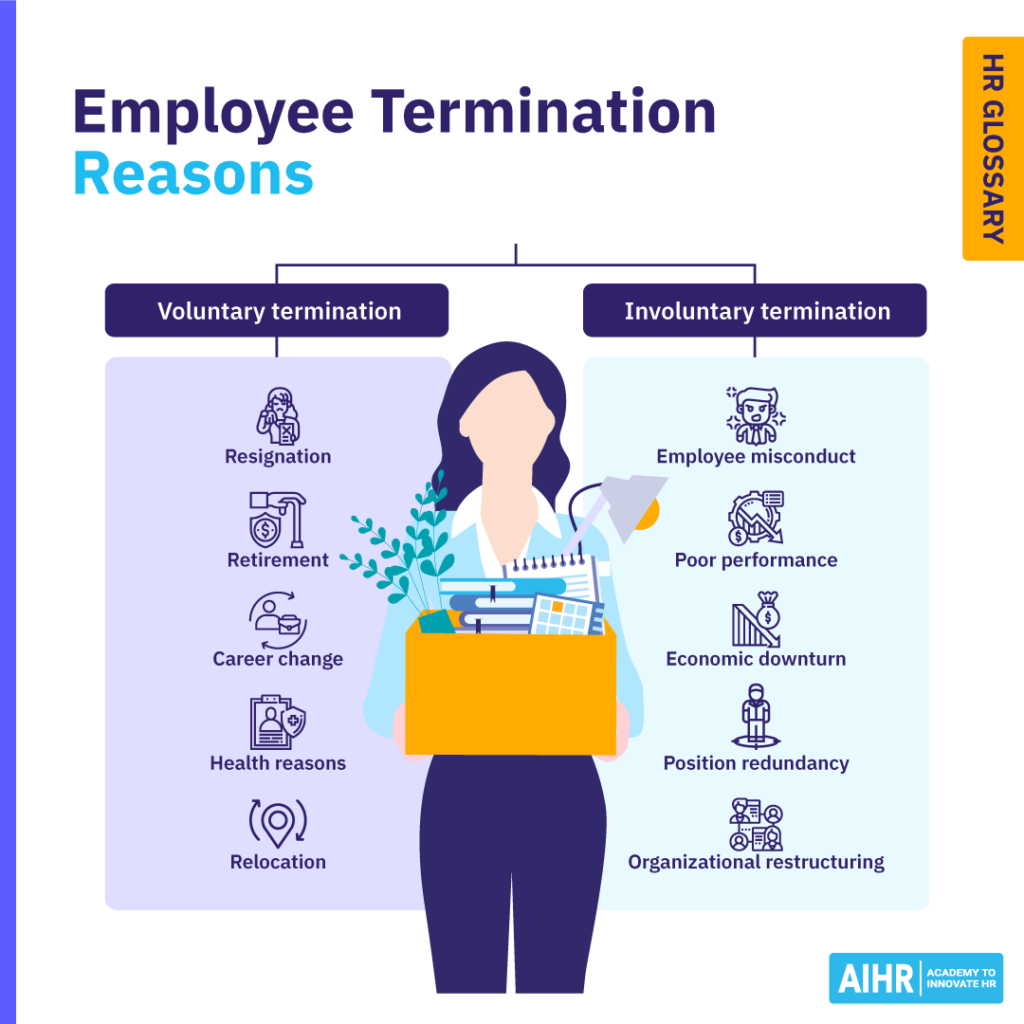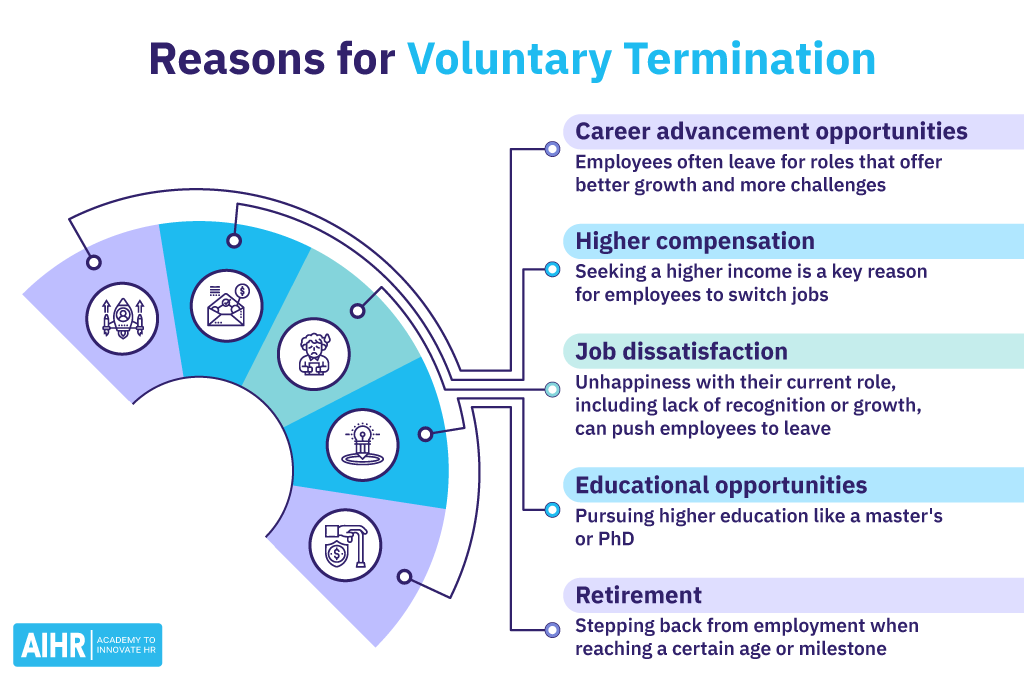Voluntary Termination
What is voluntary termination?
Voluntary termination, also known as voluntary resignation, is when an employee resigns from or leaves their job of their own accord. They typically make this decision without any pressure from the employer and for various reasons, such as pursuing a new job opportunity, changing careers, relocating, or retiring.
Unlike involuntary termination, where an employer dismisses an employee, the employee initiates voluntary termination. This process usually involves the employee providing notice to their employer according to the terms of their employment contract.
Severance packages and unemployment benefits are most commonly associated with involuntary terminations, such as layoffs or downsizing. These packages are designed to compensate for the sudden loss of employment and ease the transition for affected employees. In contrast, when an employee leaves voluntarily, they typically are not entitled to these benefits.
Voluntary vs. involuntary termination
Definition
When an employee chooses to resign from or leave an organization of their own accord
When an employer decides to end an employment relationship, often with cause
Common reasons
Resignation, retirement, pursuing other opportunities
Poor performance, misconduct, redundancy, organizational restructuring
Severance pay
Generally not applicable, unless stipulated by contract or company policy
Typically provided in cases of redundancy or layoffs
Unemployment benefits
Usually not eligible, as the decision to leave is voluntary
Eligible in cases of redundancy or layoffs (subject to local employment laws)
Legal considerations
Generally straightforward unless breach of contract occurs
Risk of legal challenges or claims if the employer doesn’t handle the termination lawfully
In summary, the main distinction between voluntary and involuntary termination is based on who initiates the separation. The employee initiates voluntary termination, while the employer initiates involuntary termination (typically due to performance issues, misconduct, or organizational changes). Employers and HR must manage both types carefully to ensure legal compliance and to maintain organizational stability.

Voluntary termination versus resignation
Voluntary termination and resignation both involve an employee deciding to leave their job, but there are some differences in how these terms are used. Resignation is a more specific term and usually refers to a situation where an employee formally notifies their employer of their intention to leave the company. Based on typical company procedure, this often involves giving a formal written notice and providing two weeks’ notice or completing any necessary paperwork before leaving.
Voluntary termination, on the other hand, is a broader term that covers any instance where an employee chooses to leave a company. While resignation falls under this category, voluntary termination of employment can also include situations like quitting without formal notice or retiring. In either case, the employee initiates the end of their employment, but resignation implies a more formal, structured process.
Amazon’s “The Offer” and voluntary termination
Amazon’s “The Offer”, or “Pay to Quit” program, provides a clear example of voluntary termination. It prompts employees, especially those in fulfillment centers, to evaluate their commitment to the company. This program offers a financial incentive for employees to leave if they no longer see a future at Amazon. The offer starts at $2,000 and increases by $1,000 each year, up to a maximum of $5,000.
By encouraging this self-reflection, Amazon can maintain a workforce of truly dedicated individuals. Though the company prefers employees to stay, the offer guarantees that those who remain are truly committed.
Reasons for voluntary termination
There are numerous reasons why an employee might leave a company voluntarily, and these reasons can vary widely depending on individual circumstances and career goals. These reasons include:
- Career advancement opportunities: Many employees leave their jobs to seek better opportunities, more challenging roles, or a career change that offers growth and advancement prospects.
- Compensation: Employees often find that the most effective way to significantly increase their income is to join another company.
- Job dissatisfaction: Unhappiness with their current job due to factors like lack of recognition, limited growth opportunities, unfulfilling work, or disagreements with management or company policies can lead to voluntary termination.
- Educational opportunities: Pursuing further education is a common reason for leaving a job. This is often the case when employees want to pursue higher education like a master’s degree or PhD, which opens doors to more advanced career opportunities.
- Retirement: Retirement traditionally occurs when an individual reaches a certain age or career milestone and decides to step down from active employment.

How should HR handle a voluntary termination?
When an employee decides to terminate their employment voluntarily, it’s crucial for HR to handle the process professionally and efficiently. Here’s a step-by-step guide:
- Receive and acknowledge the resignation: After the employee has submitted their resignation letter or email, HR should acknowledge receipt of this letter/email.
- Conduct an exit interview: An exit interview is a valuable opportunity for the organization to gain insights into its work environment, culture, and processes. Questions should focus on the employee’s motivation for leaving, their experience working for the company and any suggestions they might have for improvement.
- Manage final pay and benefits: Make sure finance processes the employee’s final paycheck, including any accrued vacation or sick leave. Also, provide information about benefits continuation or termination, as per company policy and legal requirements.
- Retrieving company property: HR is responsible for ensuring that all company property is returned. This might include items like ID badges, laptops, mobile phones, or any other equipment or materials provided to the employee.
- Announce the departure: Communicate the employee’s departure in a way that respects their privacy and keeps the team sufficiently informed. Depending on the organization’s size and structure, you can make this announcement via email or in team meetings.
- Continuous improvement: Use each voluntary termination as a learning experience. By analyzing exit interview data and the termination process, you can identify trends, issues, or opportunities for improvement in the organization.
HR tip
To minimize voluntary terminations, create a welcoming and engaging work environment that addresses key factors influencing employee satisfaction and retention. Regularly conducting stay interviews, offering competitive compensation and benefits, providing opportunities for professional growth and development, and fostering a supportive and inclusive company culture are essential strategies.
FAQ
The voluntary termination process typically involves an employee submitting a letter of resignation to their manager, stating their intention to leave their job and their last day of employment. HR may conduct an exit interview to allow the employee to provide feedback about their experience with the company. Generally, the process allows the employee to initiate an amicable departure from the organization.
Yes, voluntary termination and quitting are essentially the same. Both refer to an employee choosing to leave their job rather than being fired or laid off by their employer.
A “no call, no show” incident, where an employee fails to report to work and doesn’t notify their employer, is not automatically considered voluntary termination. However, if such behavior continues without a valid reason, it may be interpreted as job abandonment, which is a form of voluntary termination.









